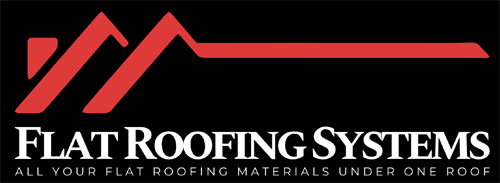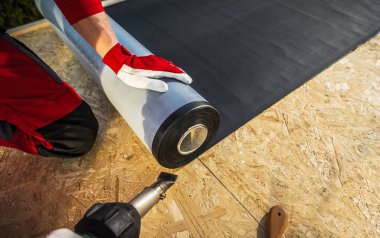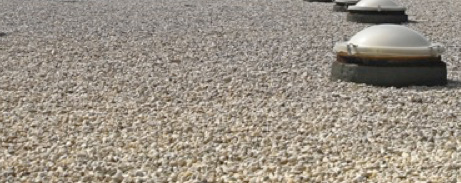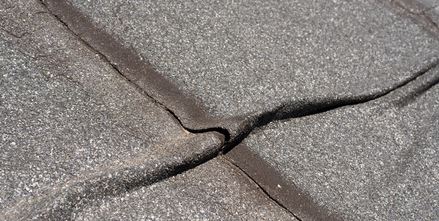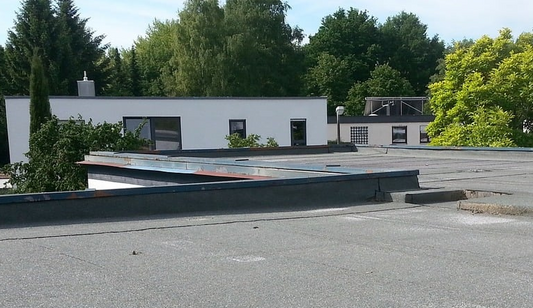How EPDM Rubber Roofing Contributes to Energy Efficiency in Buildings
EPDM rubber roofing substantially boosts your building's energy efficiency through excellent thermal insulation. Its inherent resistance to heat and cold stabilizes internal temperatures, which means you'll ultimately lower your energy costs.
In colder climates, the dark color of EPDM absorbs sunlight, providing a natural heating effect that reduces the need for artificial heating. Additionally, its ability to expand and contract without cracking under temperature changes maintains its insulative properties over time. As you explore further, you'll find even more detailed insights on how adopting EPDM can benefit your specific building needs.
Key Points
- EPDM roofing acts as a thermal barrier, reducing heat transfer and stabilizing internal temperatures.
- Its dark color absorbs heat in colder climates, lowering heating costs.
- Reflective properties of EPDM minimize heat absorption, keeping buildings cooler in warm weather.
- The material's durability extends the lifespan of roofing, reducing the frequency and cost of replacements.
- EPDM reduces HVAC system strain, leading to lower energy consumption and cost savings.
Understanding EPDM Rubber Roofing
EPDM (ethylene propylene diene monomer) rubber roofing, a durable synthetic rubber roofing membrane, is widely recognized for its cost-effectiveness and versatility.
You'll find it's particularly suited for low-slope or flat roof structures, common in both commercial and residential buildings. Unlike traditional roofing materials, EPDM won't split, crack, or rot under harsh weather conditions.
It's engineered to withstand extreme heat, freezing temperatures, and heavy rainfall, ensuring a long lifespan with minimal maintenance.
You might be surprised to learn that installing EPDM is remarkably straightforward. It can be either fully adhered, mechanically attached, or ballasted with seams sealed using liquid adhesives or specially formulated tape.
This flexibility in installation options means it can be adapted to a wide range of building types and sizes, potentially lowering installation costs.
Moreover, EPDM's dark color helps it resist UV radiation, a notable feature given its exposure to the elements. Though this aspect contributes indirectly to its durability, it's crucial to recognize that the color itself isn't a factor in its insulation properties, which are better discussed separately.
With these benefits, it's clear why EPDM is a top choice for covering roofs.
Thermal Insulation Properties
While EPDM roofing is highly praised for its resilience against environmental elements, you might be wondering about its performance in terms of thermal insulation.
EPDM rubber roofing excels here too, providing you with a layer of protection that dramatically reduces heat transfer. This characteristic means your building stays cooler in summer and warmer in winter, enhancing overall comfort.
The secret to its effective insulation lies in the material's inherent thermal resistance. EPDM's composition includes a high density that acts as a barrier against heat flow.
Unlike other materials that absorb and transmit heat, EPDM reflects and resists it, stabilizing your building's internal temperatures.
You'll also find that EPDM's colour and surface properties contribute to its insulating abilities. While traditionally black, advancements in technology allow for lighter colors that reflect more solar radiation, enhancing its thermal resistance.
Regardless of color, the smooth surface of EPDM prevents heat entrapment, supporting a steady internal climate.
Incorporating EPDM roofing can be a smart decision if you're aiming for thermal efficiency without compromising on durability. It's a straightforward solution that guarantees your space remains insulated from external temperature fluctuations, keeping it comfortable year-round.
Impact on Heating and Cooling Costs
Considering the thermal insulation properties detailed earlier, you can expect significant savings on your heating and cooling costs with EPDM roofing. This material acts like a barrier against heat loss during cold months and keeps your building cooler in the heat of summer.
What's more, the inherent properties of EPDM help maintain a steady indoor temperature, reducing the need for your HVAC system to work overtime.
You'll find that this stability means less strain on your heating and cooling systems, which not only cuts your energy bills but also prolongs the life of your HVAC units.
By installing EPDM roofing, you're fundamentally adding an extra layer of insulation to your building. This reduces the amount of energy required to heat or cool your space, leading to lower utility expenses.
Moreover, EPDM's dark color can be advantageous in colder climates by absorbing heat during sunny winter days, which further reduces the need for artificial heating.
In warmer regions, reflective coatings can be applied to EPDM roofing to repel heat and keep your interiors comfortable without excessive air conditioning.
As a result, you'll enjoy a comfortable indoor environment with reduced energy costs throughout the year.
Durability and Longevity Benefits
Beyond the cost-effective heating and cooling benefits, EPDM roofing stands out for its remarkable durability and longevity.
When you choose this type of roofing, you're investing in a material known for its ability to resist weathering, abrasion, and UV radiation. This resilience translates into a lifespan that can exceed 50 years, minimizing your repair and replacement costs over time.
You'll find that EPDM's durability is largely due to its unique composition.
The material is synthesized from ethylene, propylene, and diene monomer, which together form a rubber sheet that's both flexible and tough.
This flexibility is vital; it allows the roofing to expand and contract with temperature changes without cracking.
So, you won't have to worry about the integrity of your roof as the seasons shift.
Moreover, EPDM is remarkably resistant to the damages caused by environmental pollutants and the ozone.
This means that the material won't deteriorate quickly, maintaining its integrity through varied environmental conditions.
You can rest assured that the roof's performance won't falter, regardless of what the elements throw at it.
Choosing EPDM not only guarantees a robust, long-lasting roof but also makes a substantial contribution to the overall sustainability and efficiency of your building.
EPDM Installation Process
Installing EPDM roofing is a straightforward process that you can manage with the right tools and guidance.
First, you'll need to prepare the roof surface. It's vital that it's clean, dry, and free of any debris or sharp objects that could puncture the membrane.
Once the surface is prepped, you'll roll out the EPDM sheets. It's important to allow them to relax and flatten out, which can take about 30 minutes, depending on the weather conditions.
Next, you'll apply the adhesive. You should use a water-based adhesive for adhering the membrane to the decking and a contact adhesive for the edges and any details.
Make sure you follow the manufacturer's directions closely for the best results. Apply the adhesive evenly and wait for it to become tacky before laying down the membrane.
Once the adhesive is tacky, you can start laying the EPDM membrane, working from one end of the roof to the other. Use a push broom or a roller to smooth out any air bubbles and confirm good contact with the adhesive.
Finally, install any flashing or edge details to confirm the roof is watertight.
That's it! With some patience and precision, you've got a weather-resistant, energy-efficient roof that'll last for years.
Case Studies of EPDM Efficiency
Many have experienced substantial benefits from installing EPDM rubber roofing, as evidenced by various case studies highlighting its efficiency.
One notable example is a large commercial building in Phoenix, where the summer temperatures soar. After switching to EPDM, the building's management reported a 30% reduction in cooling costs, attributed to the material's excellent reflective properties.
In Chicago, a residential complex with EPDM roofing saw its heating costs decrease markedly during harsh winters. The thermal resistance of EPDM helped maintain indoor temperatures, demonstrating not only its effectiveness in warm climates but also in colder ones.
You'll find these benefits aren't isolated incidents. EPDM stands out:
- Durability: EPDM roofs have a long lifespan, reducing the frequency and cost of replacements.
- Versatility: Suitable for different climates and building designs.
- Cost-effectiveness: Offers a good balance of low initial investment and long-term savings on energy bills.
These examples illustrate how EPDM not only enhances energy efficiency but also adapts to various environmental conditions, making it a smart choice for a wide range of buildings.
Maintenance and Energy Performance
While EPDM roofing brings notable energy savings, maintaining its performance over time is equally important.
You'll find that regular inspections and timely repairs are key to sustaining its energy efficiency. Typically, you should check your EPDM roof bi-annually, in the spring and fall, to catch and address any issues like seam splits or punctures.
Cleaning your roof is also vital. Dirt and debris can accumulate, leading to water pooling and increased wear.
By keeping the surface clean, you're not just prolonging the roof's life but also guaranteeing it reflects more sunlight, thereby maintaining its cool roof properties. This reflection is essential as it directly impacts your building's cooling costs.
Moreover, you should be mindful of the insulation under your EPDM membrane. Compromised insulation doesn't just risk water damage; it also reduces the roof's thermal resistance.
To avoid this, verify that any moisture within the roofing system is swiftly dealt with, either through repairs or replacement of the affected sections.
Future Trends in EPDM Technology
Looking ahead, the future of EPDM technology promises innovative advancements that could revolutionize its application and effectiveness.
As you explore options for sustainable building materials, it's essential to understand where EPDM roofing is headed. One of the most exciting prospects is the integration of nanotechnology into EPDM composites.
This could markedly enhance its thermal and mechanical properties, ensuring better insulation and durability. You'll find that these improvements not only extend the life of the roof but also contribute to overall energy savings.
Additionally, the development of bio-based EPDM is gaining momentum. Researchers are working on ways to manufacture EPDM using renewable resources, which will reduce environmental impact and potentially lower costs.
This shift is pivotal as industries move towards more sustainable practices.
To give you a clearer picture:
- Enhanced recyclability: Efforts are increasing to make EPDM fully recyclable, reducing landfill waste.
- Smart roofing systems: Incorporation of sensors to monitor conditions and maintain energy efficiency.
- Increased UV resistance: Improvements in formulation to prevent degradation from sunlight.
These advancements show that EPDM roofing isn't just keeping up with the times; it's poised to lead in the eco-friendly materials revolution.
Keep an eye on these trends as they develop; they're sure to impact how you think about roofing solutions.
Rounding Up
You've seen how EPDM rubber roofing stands out not just for its durability but also for its superb energy efficiency. By optimizing your building's temperature, it slashes your heating and cooling costs. The installation process is straightforward, and maintenance is minimal, ensuring long-lasting performance. With ongoing advancements in EPDM technology, it's clear this roofing material is a smart choice for the future. So, consider EPDM to enhance your building's energy efficiency and embrace a greener, cost-effective future.
